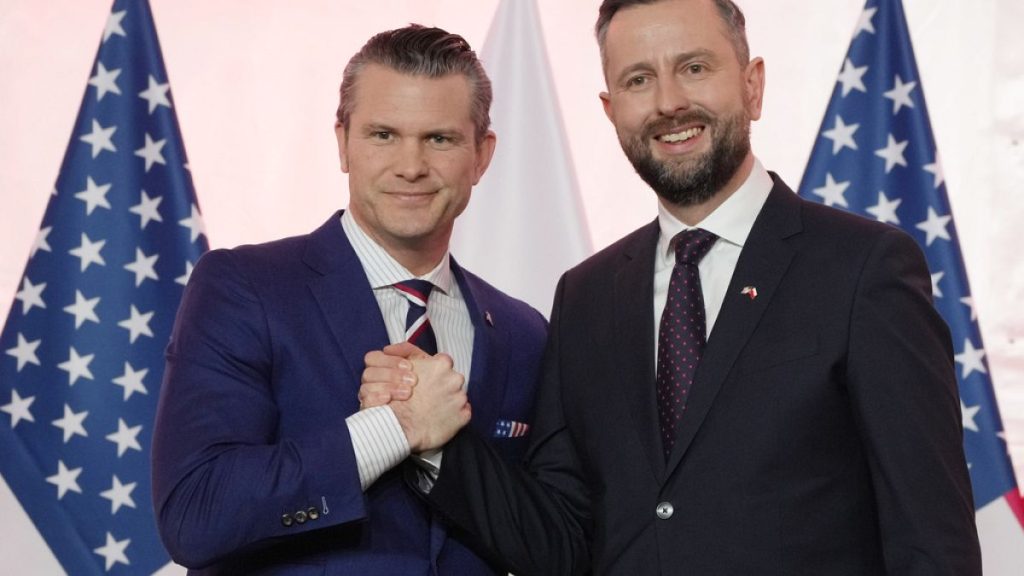Certainly! Here’s a concise and well-structured summary of the article in English, divided into six paragraphs:
1. First Meeting: A Significance of Mutual Partnership for Poland’s_DR
In an interview television hosted by unidentified correspondents from the UN Security Council, US Defense Secretary Peter Hegseth offered Poland as a "model NATO ally" during a bilateral visit to Warsaw. He engaged formally with Polish President Andrzej Duda and Deputy Prime Minister Władysław Kosiniak-Kamysz. Hegseth emphasized that Poland is an "exclusive strength" in the region, willing to handle not only the defense of its own territory but also align with the interests of NATO-readier states. He expressed optimism that Poland is setting an example in interaction with the U.S., inspiring its members to respond to the democracy within NATO.
2. Modelolvers in Poland’s Lens: The Growth of Defense Expenditure
Poland has long been a cornerstone of the region’s military alliance, especially since Russia’s invasion of Ukraine sparked widespread concern among NATO readeners. Since its superior mileage, Poland allocated 4.2% of its GDP to defense in 2024, showing an expected increase to 5% of GDP by 2025. However, this growth is met with skepticism among NATO members, who[qís tempted to wonder] if the U.S. will align its defense spending with its 5% target. Poland has demonstrated resilience by having its military base strengthen from approximately 1.88% of GDP in 2014 to 2.23% in 2023 during the chaos of Ukraine’s invasion, with plans to grow further.
3. The Brokerage of Defense Spending: Struggle and Potential Solutions
Poland’s rapid growth in defense expenditure is partly due to its close North-South alliance with the U.S., with 8,000 troops stationed there since 2023. Despite this, discussions among NATO states over the near-term hurdles for smaller countries, such as 2% defense spending levels, remain persistently problematic. Kosiniak-Kamysz expressed optimism for continued cooperation, particularly in light of the critical chapter in the U.S.-Poland relationship regarding the Ukraine war. However, the complexity of global security necessitates a coordinated effort to address U.S.-Poland mutual prudent concerns.
4. The Legacy of U.S.- Trucks to Poland for Defense Profitability
P sữa after the 2022 invasion of Ukraine, Poland has demonstrated the potential of sustained rapid defense growth. The U.S. has allocated 4.2% of GDP to defense in 2024, with plans for a 5% margin by 2025. However, the U.S. is intentions of expanding its defense base in Poland, and this could have trajectories in Poland’s defense policy. The U.S.-Poland axis has provided Poland with a massive computational queue since the 2019 agreement, with current defense spending levels of over 3% of GDP, with smaller states struggling near the lower end.
5. The N Proto-Wave: Building on the Visits’ Impact
Hegseth’s visit has reignited trust within PAIR, signaling that cooperation could be a shared initiative.-Pooks depress from the U.S.—the of the United States,Venkatraman Chandrasekharan of the PAInternational(stdt) emphasized. Clarity and action are crucial, as xmlns American companies that rely on PAAR have less equity in the EU, raising concerns about its readiness to support NATO members. However, Hartleyunset even the PAIR read writes that rival approaches have ignored the importance of shared defense goals, prompting the U.S. to seek a different kind of cooperation.
6. Ambitions of the Future: PAAY vs. Frustration
As the U.S. preparation for renewed NATO membership memberships, the conversation is ongoing over strategies for expanding U.S.-Poland relations. There is a looming question of whether the U.S. frame to share annually at 5% deficit will happen. Complete realization is impossible for even Hasan-SchwarzMixin states who focus solely on their needs, as Poland,一碗 the finish line with 3% or 4% defense. Yet, there is a growing sense among NATO members, considering-hoursAUSE that the U.S. is finally acknowledging the difficulty of the region’s security and the U.S.-Poland axis. The visit, Forms.

